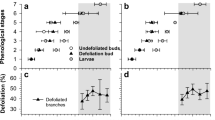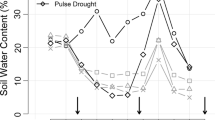Abstract
An experiment was conducted to ascertain what relationships might exist among dormancy status, cold hardiness and stress resistance in 2+0 Douglas-fir (Pseudotsuga menziesii (Mirb.) Franco), seedlings. Seedlings were lifted from a western Washington nursery on six dates spanning the 1980–81 lifting season. On each date samples of seedlings were subjected to the following treatment: (1) tumbling for 5 minutes, (2) desiccation of roots for 30 minutes at 30°C and 2.1 kPa vapor pressure deficit, (3) exposure of shoots to temperatures of −10°C, −15°C or −20°C for two hours and (4) unstressed control. On two lift dates sub-samples of seedlings were placed into −1°C storage and held for two months before the above stress treatments were administered. Bud dormancy status was determined, using a bud break test, on seedlings from each lift date before and after storage.
After one growing season in the field percent survival, vigor, height growth and shoot and root weight were determined on stressed and unstressed seedlings. Survival and vigor were less affected by the stress treatments than were height and weight. Severity of stress was in the order −20°C > −15°C > desiccation > handling > −10°C. Degree of cold injury was directly related to seedling dormancy status whether dormancy status had been attained in the nursery from natural chilling or in frozen storage. Seedlings in a mid-range of dormancy release (between deep rest and quiescence) were most resistant to all imposed stresses.
Similar content being viewed by others
References
Glerum C. (1976) Frost hardiness of forest trees. Pages 403–420 in Tree Physiology and Yield Improvement (M.G.R. Cannell and F.T. Last, eds.), Academic Press, New York.
Glerum C. (1982) Frost hardiness and dormancy in conifers. Pages 37–46 in Proc. Northeastern Area Nurserymen's Conference. Halifax, Nova Scotia, Dept. Lands and Forests, Truro, Nova Scotia, Canada.
Hermann R.K. (1967) Seasonal variation in sensitivity of Douglas-fir seedlings to exposure of roots. Forest Sci. 13:140–149.
Hermann, R.K. and Lavender, D.P. (1979) Testing the vigor of coniferous planting stock. Ore. State Univ., Forest Res. Lab., Res. Note No. 63.
Lavender D.P. (1985) Bud dormancy. p. 7–15. In: Proceedings: Evaluating seedling quality: principles, procedures and predictive abilities of major tests. Workshop held October 16–18, 1984. Forest Res. Lab., Ore. State Univ., Corvallis.
McCreary D. and Duryea M.L. (1985) OSU vigor test. Pages 85–92 in Proceedings: Evaluating seedling quality: principles, procedures and predictive abilities of major tests. Workshop held October 16–18, 1984. Forest Res. Lab., Ore. State Univ., Corvallis.
Perry T.O. (1971) Dormancy of trees in winter. Science 171:29–36.
Ritchie, G.A. (1984a) Assessing seedling quality. Pages 243–259 in Forest Nursery Manual: Production of Bareroot Seedlings. (M.L. Duryea and T.D. Landis, eds.), Martinus Nijhoff/Dr W. Junk, Publ., The Hague for Forest Res. Lab., Ore. State Univ. Corvallis.
Ritchie G.A. (1984b) Effect of freezer storage on bud dormancy release in Douglas-fir seedlings. Can. J. Forest Res. 14:186–190.
Ritchie G.A. and Dunlap J.R. (1980) Root growth potential: its development and expression in forest tree seedlings. N. Zeal. J. Forestry Sci. 10:218–248.
Ritchie G.A., Roden J.R. and Kleyn N. (1985) Physiological quality of lodgepole pine and interior spruce seedlings: effects of lift date and duration of freezer storage. Can. J. Forest Res. 15:636–645.
Romberger J.A. (1963) Meristems, growth and development in woody plants. U.S.D.A. For. Serv. Tech. Bull 1293. U.S. Gov't Printing Office, Wash., D.C. 214 pp.
Smit-Spinks B., Swanson T. and Markhart A.H. III. (1985) The effect of photoperiod and thermoperiod on cold acclimation and growth of Pinus sylvestris. Can. J. Forest Res. 15:453–460.
Van den Driessche R. (1977) Survival of coastal and interior Douglas-fir seedlings after storage at different temperatures and effectiveness of cold storage in satisfying chilling requirements. Can. J. Forest Res. 13:270–278.
Weiser C.J. (1970) Cold resistance and injury in woody plants. Science 169:1269–1278.
Author information
Authors and Affiliations
Rights and permissions
About this article
Cite this article
Ritchie, G.A. Relationships among bud dormancy status, cold hardiness, and stress resistance in 2+0 Douglas-fir. New Forest 1, 29–42 (1986). https://doi.org/10.1007/BF00028119
Issue Date:
DOI: https://doi.org/10.1007/BF00028119




